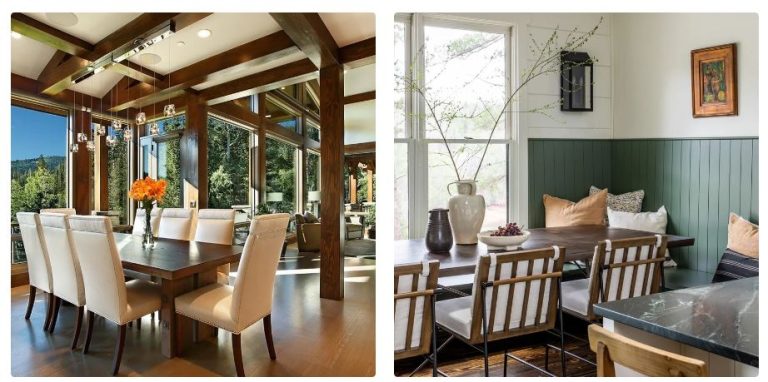Because it is rooted in craftsmanship, nostalgic, and thoughtfully chosen, rustic dining room design has a particularly emotional appeal. Celebrities like Reese Witherspoon and Diane Keaton have been showcasing their love of rustic interior design over the past five years. They have done so by showcasing homes that are built on reclaimed wood, worn textiles, and simple elegance. These areas evoke a sense of subdued luxury, providing a deliberate respite from the hectic pace of contemporary design.
The table is the focal point of any well-designed rustic dining area. Big farmhouse-style tables add both practicality and poetic character, particularly when made from repurposed wood. It feels like there is a tale to be told over dinner with every gouge or knot in the wood. The table is more than just furniture; it’s heritage, preserved in planks, especially in homes created by designers like Amber Lewis or M.T.N Design.
Rustic Dining Room Ideas
| Key Element | Description |
|---|---|
| Primary Material | Reclaimed wood, aged metals, natural stone |
| Recommended Table Type | Trestle-style, live-edge, or round pedestal made from solid hardwood |
| Seating Style | Distressed chairs, benches with cushions, leather high-backs |
| Color Palette | Earthy tones: sage green, muted terracotta, creamy beige, ash gray |
| Flooring Choice | Wide plank oak, hand-scraped walnut, reclaimed pine |
| Lighting Fixtures | Iron chandeliers, antler pendants, Edison bulb sconces |
| Popular Decor Accents | Vintage rugs, hand-thrown ceramics, barn doors, nature-themed wall art |
| Storage Pieces | Open shelving, rustic sideboards, farmhouse buffets |
| Influential Designers | Amber Lewis, Heidi Caillier, Joanna Gaines |
| Cultural Trend Connection | Embraces slow living, sustainability, and a renewed love for artisan craftsmanship |
Homeowners purposefully break up visual uniformity by combining these tables with mismatched chairs, some of which are upholstered and others of which are left bare, giving the room a lived-in, casual feel. This layering allows a subtle story to emerge. It’s also not limited to retreats in the country. Rustic accents can transform even a Brooklyn brownstone or a bungalow in Los Angeles, particularly when textures like linen drapes or cowhide rugs are carefully incorporated.
This style is still characterized by exposed beams, whether they are structural or decorative. These details serve as visual links between traditional inspiration and modern application; they are frequently left unfinished or lightly stained. Designers have been keeping original ceilings in more and more Northern California renovation projects, highlighting the growing desire for authenticity over polish.
Unexpectedly, lighting has a big impact on how these spaces look. Designers are moving away from sterile fixtures and toward items that have an inherited or handmade feel. When hung over a rough-hewn table, wrought iron chandeliers and Edison-bulb pendants produce an incredibly powerful atmosphere. An additional touch of rustic inventiveness can be added to some high-end homes by repurposing old lanterns into hanging lights.
It is practical and aesthetically pleasing to include storage that reflects the rustic style. In addition to providing surface space for displaying pottery, baskets, or framed botanical prints, a weathered buffet or sideboard enables homeowners to store serving pieces or linens neatly. Installations that transform old doors into built-in cabinets are especially creative because they skillfully blend form, memory, and utility.
Color schemes stay muted but never boring. More vivid colors are used sparingly, usually in textiles or small pieces of décor, while tones like denim blue, sage, mushroom, and clay are used to create an inviting atmosphere. The end effect is a unified area that seems carefully chosen but dynamic. A room becomes immensely adaptable to changing seasons and personal preferences when it permits layered, gradual decor changes.
Additionally, rugs have developed into strong focal points for rustic dining rooms. To ground the room and add cozy, woven textures, designers such as Sara Brennan frequently place Turkish or Southwestern-patterned rugs beneath the dining set. In addition to being aesthetically pleasing, these rugs aid in defining the dining area in open-concept homes, which is especially useful in contemporary construction where there are few walls.
Crucially, it is impossible to ignore the social impact of rustic design. Building interiors that reflect comfort, sustainability, and permanence is becoming more and more popular as homeowners abandon disposable decor trends. By means of strategic collaborations with regional artisans and providers of repurposed materials, certain boutique interior design studios are reinventing luxury through patina and provenance rather than gloss.
Faux beams or barn doors offer stylistic shortcuts without requiring structural overhauls for urban dwellers lacking architectural rusticity. Barn sliders mounted on the wall are now frequently used as pantry doors or decorative partitions in interior makeovers, providing a rustic look without sacrificing contemporary functionality. When it comes to giving sterile, newly constructed properties personality, these details work especially well.
It’s interesting to note that rustic dining rooms frequently serve as a home’s emotional center. The dining area, particularly in a rustic setting, promotes pause, in contrast to kitchens or lounges that place more emphasis on movement or media. It’s where electronic gadgets are put away and where the custom of eating meals together takes back its place. This cultural reversal from constantly multitasking to purposeful hosting reflects broader changes in lifestyle toward mindfulness.
In the future, rustic interior design will likely become more popular as the housing market shifts more toward sustainable development. Reclaimed architectural elements are already being incorporated into upscale new constructions by designers and builders. These selections make rustic dining room ideas more than just stylish options; they’re declarations of continuity, community, and values.


